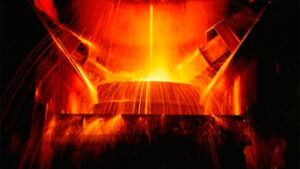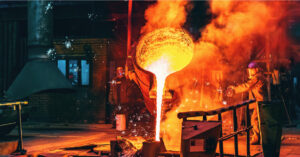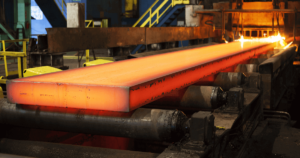
Metallurgical enterprises of Ukraine in March of this year increased steel production by 15.8% compared to the same period in 2023 – to 611 thousand tons from 527 thousand tons.
At the same time, Ukraine took 21st place in the ranking of 71 countries – global producers of these products, compiled by the World Steel Association (Worldsteel).
According to Worldsteel, in March an increase in steel production was recorded by March 2023 in most countries of the top ten, except China, Japan and South Korea.
The top ten steel-producing countries at the end of March are as follows: China (88.270 million tons, a decrease of 7.8% compared to March 2023), India (12.709 million tons, an increase of 7.8%), Japan (7.197 million tons , decrease by 3.9%), USA (6.906 million tons, at the level of March 2023), Russia (6.640 million tons, increase by 0.8%), South Korea (5.282 million tons, down by 9.5%) , Germany (3.510 million tons, up 8.4%), Turkey (3.202 million tons, up 18%), Brazil (2.787 million tons, up 5.6%) and Iran (2.774 million tons, up 2 %).
In total, in March 2024, steel production decreased by 4.3% compared to the same period in 2023 – to 161.190 million tons.
In January-March 2024, the top ten steel producing countries are as follows: China (256.550 million tons, a decrease of 1.9% compared to January-March 2023), India (37.327 million tons, an increase of 9.7%), Japan ( 21.452 million tons, down 0.8%), USA (19.936 million tons, down 1.6%), Russia (18.680 million tons, down 0.2%), South Korea (16.245 million tons, down 2 .5%), Germany (9.704 million tons, an increase of 6%), Turkey (9.533 million tons, an increase of 28.4%), Brazil (8.293 million tons, an increase of 6.2%) and Iran (7.616 million tons , higher by 16.3%).
In general, over the 3 months of 2024, steel production increased by 0.5% compared to the same period in 2023 – to 469.060 million tons.
At the same time, Ukraine produced 1.687 million tons of steel in 3 months of 2024, which is 36.6% higher than the volumes for the same period in 2023 (for 3 months of 2023 – 1.235 million tons). The country is in 22nd place based on the results of 3 months – 2024.
As reported, in 2023, China produced 1 billion 19.080 million tons at the level of the previous year), India (140.171 million tons, +11.8%), Japan (86.996 million tons, -2.5%), USA (80.664 million tons , +0.2%), Russia (75.8 million tons, +5.6%), South Korea (66.676 million tons, +1.3%), Germany (35.438 million tons, -3.9%), Turkey (33.714 million tons, -4%), Brazil (31.869 million tons, -6.5%) and Iran (31.139 million tons, +1.8%).
In total, 71 countries produced 1 billion 849.734 million tons of steel in 2023, which is 0.1% less than in 2022.
At the same time, Ukraine produced 6.228 million tons of steel in 2023, which is 0.6% lower than the volumes for 2022. The country is in 22nd place by the end of 2023.
At the end of 2022, the top ten steel producing countries looked like this: China (1.013 billion tons, -2.1%), India (124.720 million tons, +5.5%), Japan (89.235 million tons, -7.4 %), USA (80.715 million tons, -5.9%), Russia (71.5 million tons, -7.2%), South Korea (65.865 million tons, -6.5%), Germany (36.849 million tons , -8.4%), Turkey (35.134 million tons, -12.9%), Brazil (33.972 million tons, -5.8%) and Iran (30.593 million tons, +8%).
At the end of 2022, Ukraine took 23rd place with the production of 6.263 million tons of steel (-70.7%).
In total, in 2022, 64 countries produced 1 billion 831.467 million tons of steel, which is 4.3% less than in 2021.

Global steel demand will increase by 1.7% to 1.793 billion tons in 2024 and by another 1.2% to 1.815 billion tons in 2025, the World Steel Association predicts.
Martin Theuringer, Chairman of the Worldsteel Economic Committee, noted in his commentary that after two years of negative growth and severe market volatility following the COVID crisis in 2020, there are first signs of stabilization of global steel demand on a growth trajectory in 2024 and 2025.
According to him, the global economy continues to demonstrate resilience despite several strong headwinds, the lingering impact of the pandemic and Russia’s invasion of Ukraine, high inflation, high costs and falling household purchasing power, growing geopolitical uncertainty and sharp monetary tightening.
“As we approach the end of the monetary tightening cycle, we have seen that tighter credit conditions and higher costs have led to a sharp slowdown in housing activity in most major markets and weighed on the manufacturing sector globally. While it appears that the global economy will experience a soft landing after this cycle of monetary tightening, we expect global steel demand growth to remain weak and market volatility to remain high due to the lagged effects of monetary tightening, high costs and high geopolitical uncertainty,” the head of the economic committee said.
China’s steel demand in 2024 is expected to remain roughly at the level of 2023 as real estate investment continues to decline, but the corresponding loss in steel demand will be offset by an increase in steel demand driven by infrastructure investment and manufacturing sectors. In 2025, steel demand in China will return to a downward trend with a 1% decline.
This forecast implies that by 2025, China’s steel demand will be significantly lower than in the recent peak year of 2020. This forecast is also in line with Worldsteel’s view that China may have reached its peak steel demand and that steel demand in the country is likely to continue to be strong in the medium term as China gradually moves away from an economic development model dependent on real estate and infrastructure investment.
Worldsteel’s forecasts for the world, excluding China, assume broad-based growth in steel demand at a relatively high 3.5% per year in 2024-2025.
It also states that India has become the strongest driver of steel demand growth since 2021, and the forecast shows that steel demand in India will continue to grow rapidly, with steel demand in the country growing by 8% in 2024 and 2025, driven by growth in all steel-using sectors and especially by continued strong growth in infrastructure investment. India’s steel demand is projected to be almost 70 million tons higher in 2025 than in 2020.
In other emerging economies such as the Middle East, Africa and ASEAN, steel demand is expected to grow in 2024-2025 after a significant slowdown in 2022-2023. However, growing challenges in ASEAN, such as political instability and declining competitiveness, may lead to a slowdown in steel demand growth in the future.
The developed world is also expected to see a stronger recovery: 1.3% in 2024 and 2.7% in 2025, as Worldsteel expects steel demand to finally show strong growth in the EU in 2025 and remain resilient in the US, Japan and Korea.
According to the forecast, the EU (and the UK) remain the region currently facing the biggest challenges. The region, and in particular its steel-using industries, is facing challenges on multiple fronts: geopolitical shifts and uncertainty, high inflation, monetary tightening and partial withdrawal of fiscal support, and still high energy and commodity prices. The persistence of these negative factors has led to a significant drop in steel demand in the region in 2023 to the lowest level since 2000 and a significant downward revision of the forecast for this year. After only a technical recovery in 2024, steel demand in the region is expected to finally show a significant recovery with growth of 5.3% in 2025. Projected steel demand in the EU in 2024 is only 1.5 million tons higher than during the 2020 pandemic.
In contrast to the EU, US steel demand continues to demonstrate healthy steel demand fundamentals. The country’s steel demand is expected to quickly return to growth in 2024 after a sharp drop caused by the housing market slowdown in 2023, thanks to strong investment activity, boosted by the inflation reduction law, and a gradual recovery in housing activity.
Worldsteel believes that risks have decreased since its last forecast update in October 2023 and are balanced. On the other hand, the Association believes that faster-than-expected disinflation, accompanied by further monetary policy easing, could provide a significant boost to steel-using sectors, especially residential construction. Worldsteel also believes that accelerating global decarbonization efforts or efforts to strengthen public infrastructure to combat the growing risks of climate change are significant positive risks that could support global steel demand going forward.
“However, we observe that further escalation of geopolitical tensions, inflationary pressures proving more resilient than expected, and high and rising public debt levels driving fiscal consolidation in major economies pose significant risks that could certainly slow or even derail the ongoing economic recovery,” the forecast concludes.

According to Metinvest Group’s annual report, in 2023 Metinvest’s revenue decreased by 11% to $7.397 bln by 2022, mainly due to lower steel, iron ore and coking coal selling prices, which were in line with global rates. Also, sales volumes of pig iron, slabs, flat and tubular products were affected by the war from the suspension of production at Mariupol steel mills. At the same time, Metinvest increased shipments of other products in its portfolio (primarily billets by 6%, long products by 28%, pellets by 70% and coking coal concentrate by 32%), as well as steel and coke resales on the back of higher production at Zaporizhstal.
A significant factor supporting iron ore sales in H2 2023 was the opening of the Black Sea corridor for sales to distant markets.
Also, Metinvest’s revenue in Ukraine grew by 14% to $2.628 bln mainly due to a recovery in demand for iron ore and coking coal, as well as for flat and long products.
In turn, the group has had to make profound changes to its business operations as it continues to strive for adaptability and resilience.
“We have adjusted our supply chain and are strengthening relationships with our suppliers and customers to withstand the current conditions. At the beginning of 2023, the company experienced significant challenges, particularly due to power outages. However, by implementing the necessary changes to respond to this crisis, we were able to achieve a gradual recovery of production,” states the CEO.
He emphasized that the resumption of Ukrainian commercial shipping in the Black Sea later in 2023 was an important moment for Metinvest, allowing to increase capacity utilization. “We are cautiously optimistic about this undoubtedly positive development, while recognizing the ongoing military threats,” the top manager added.
According to him, these developments have directly impacted the group’s financial performance, improving the situation and allowing us to focus on operational efficiency, flexibility and strategic planning for future growth.
“Metinvest remains committed to servicing its debt obligations, having repaid the remaining principal amount of the group’s 2023 bonds redeemed last year on time and in full, while maintaining its deleveraging approach, Ryzhenkov said.
“Although Metinvest has focused its investments in 2023 mainly on maintaining its assets, I firmly believe that we must start preparing for the future. Our ambitions have not diminished; we have laid the foundation for Steel Dream, our visionary vision for rebuilding Ukraine. Despite the war, our commitment to a green transformation strategy also remains unchanged. This vision embodies our determination not only to dream, but also to plan a pilot project on low-carbon steel technology in Italy,” summarized the CEO.
“Metinvest consists of mining and metallurgical enterprises located in Ukraine, Europe and the United States. Its major shareholders are SCM Group (71.24%) and Smart Holding (23.76%), jointly managing it.
COKING COAL, IRON ORE, METINVEST, PIG IRON, REVENUE, ROLLED PRODUCTS, slabs, STEEL

According to Ukrmetallurgprom, Ukrainian metallurgical enterprises increased steel production by 91.6% in January this year, up to 544 thousand tons from 284 thousand tons in January 2023.
As reported, in 2023, Ukraine increased production of total rolled products by 0.4% compared to 2022 to 5.372 million tons, but reduced steel production by 0.6% to 6.228 million tons.
Ukraine reduced steel production by 70.7% in 2022. In 2021, 21.366 million tons of steel were produced (103.6%).

In January this year, Zaporizhzhia-based Zaporizhstal Iron and Steel Works increased its rolled steel output by 2.6 times year-on-year, up to 196 thousand tons from 74.6 thousand tons.
According to the company’s information on Monday, steel production during this period also increased by 2.6 times to 235.5 thousand tons, and pig iron production by 56.9% to 261 thousand tons.
In December 2023, Zaporizhstal produced 265.5 thousand tons of iron, 228.6 thousand tons of steel, and shipped 206.5 thousand tons of rolled products.
“The increase in production in January 2024 compared to the same period last year is due to the removal of blast furnace No. 2 from hot mothballing and the establishment of three blast furnaces in March 2023,” the press release explains.
As reported, in 2023, Zaporizhstal increased its rolled steel output by 57.2% compared to 2022, up to 2 million 54.7 thousand tons, steel by 65.4%, up to 2 million 466.9 thousand tons, and pig iron by 35.3%, up to 2 million 718.9 thousand tons.
In 2023, the plant operated at an average of 70% of its capacity.
“Zaporizhstal is one of the largest industrial enterprises in Ukraine, whose products are in great demand among consumers both in the domestic market and in many countries around the world.
“Zaporizhstal is in the process of integration into Metinvest Group, whose major shareholders are System Capital Management (71.24%) and Smart Holding (23.76%).
Metinvest Holding LLC is the management company of Metinvest Group.

In January-November this year, Ukrainian steelmakers cut production of total rolled steel by 7.2% year-on-year to 4.864 million tons, according to preliminary data.
According to Ukrmetallurgprom on Friday, in the first 11 months of this year, steel production decreased by 7.3% compared to January-November 2022, to 5.707 million tons.
Pig iron production during this period decreased by 11.3% to 5.447 million tons.
As reported, in 9M2023, Ukraine reduced production of total rolled products by 17% year-on-year to 3.929 million tons, steel by 16.9% to 4.590 million tons, and pig iron by 19.5% to 4.394 million tons.
In 2022, the country’s steelmaking companies reduced production of total rolled products by 72% year-on-year to 5.350 million tons, steel by 70.7% to 6.263 million tons, and pig iron by 69.8% to 6.391 million tons.
In 2021, the company produced 21.165 million tons of pig iron (103.6% compared to 2020), 21.366 million tons of steel (103.6%), and 19.079 million tons of rolled products (103.5%).